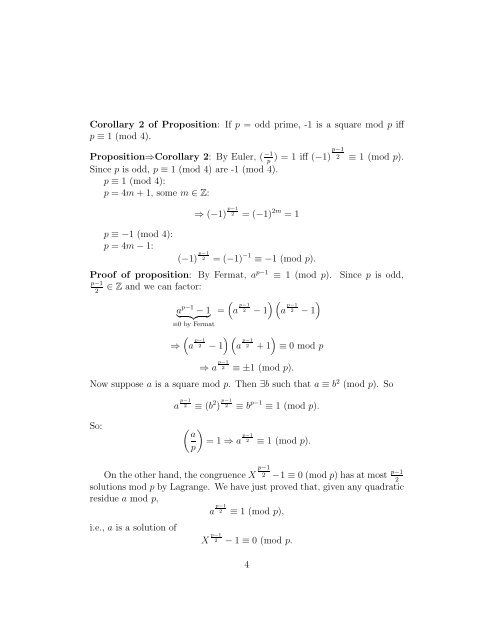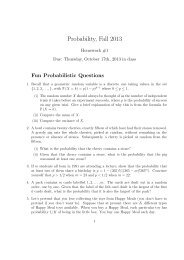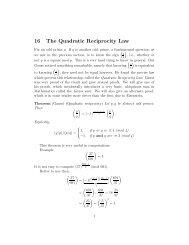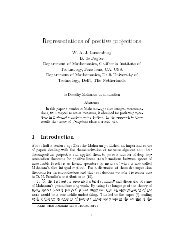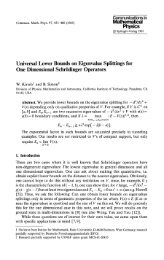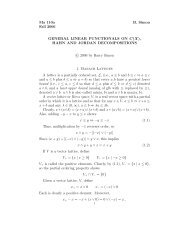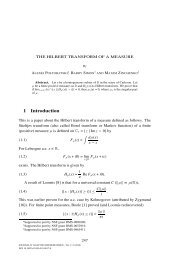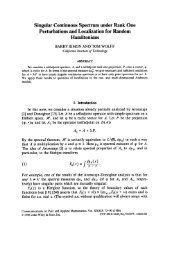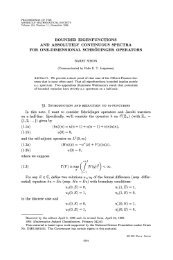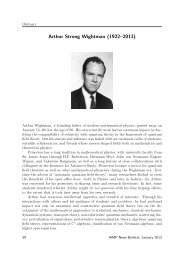15 Squares mod p
15 Squares mod p
15 Squares mod p
You also want an ePaper? Increase the reach of your titles
YUMPU automatically turns print PDFs into web optimized ePapers that Google loves.
Corollary 2 of Proposition: If p = odd prime, -1 is a square <strong>mod</strong> p iff<br />
p ≡ 1(<strong>mod</strong>4).<br />
Proposition⇒Corollary 2: ByEuler,( −1<br />
p<br />
Since p is odd, p ≡ 1 (<strong>mod</strong> 4) are -1 (<strong>mod</strong> 4).<br />
p ≡ 1(<strong>mod</strong>4):<br />
p =4m +1,somem ∈ Z:<br />
p ≡−1(<strong>mod</strong>4):<br />
p =4m − 1:<br />
⇒ (−1) p−1<br />
2 =(−1) 2m =1<br />
(−1) p−1<br />
2 =(−1) −1 ≡−1(<strong>mod</strong>p).<br />
)=1iff(−1) p−1<br />
2 ≡ 1(<strong>mod</strong>p).<br />
Proof of proposition: By Fermat, ap−1 ∈ Z and we can factor:<br />
≡ 1(<strong>mod</strong>p). Since p is odd,<br />
p−1<br />
2<br />
a p−1 <br />
− 1<br />
<br />
=<br />
≡0 byFermat<br />
⇒<br />
<br />
a p−1<br />
2 − 1<br />
<br />
a p−1<br />
<br />
2 − 1 a p−1<br />
<br />
2 − 1<br />
<br />
a p−1<br />
2 +1<br />
⇒ a p−1<br />
2 ≡±1(<strong>mod</strong>p).<br />
<br />
≡ 0<strong>mod</strong> p<br />
Now suppose a is a square <strong>mod</strong> p. Then∃b such that a ≡ b 2 (<strong>mod</strong> p). So<br />
a p−1<br />
2 ≡ (b 2 ) p−1<br />
2 ≡ b p−1 ≡ 1(<strong>mod</strong>p).<br />
So: <br />
a<br />
=1⇒ a<br />
p<br />
p−1<br />
2 ≡ 1(<strong>mod</strong>p).<br />
On the other hand, the congruence X p−1<br />
2 −1 ≡ 0(<strong>mod</strong> p) has at most p−1<br />
2<br />
solutions <strong>mod</strong> p by Lagrange. We have just proved that, given any quadratic<br />
residue a <strong>mod</strong> p,<br />
i.e., a is a solution of<br />
a p−1<br />
2 ≡ 1(<strong>mod</strong>p),<br />
X p−1<br />
2 − 1 ≡ 0(<strong>mod</strong> p.<br />
4


